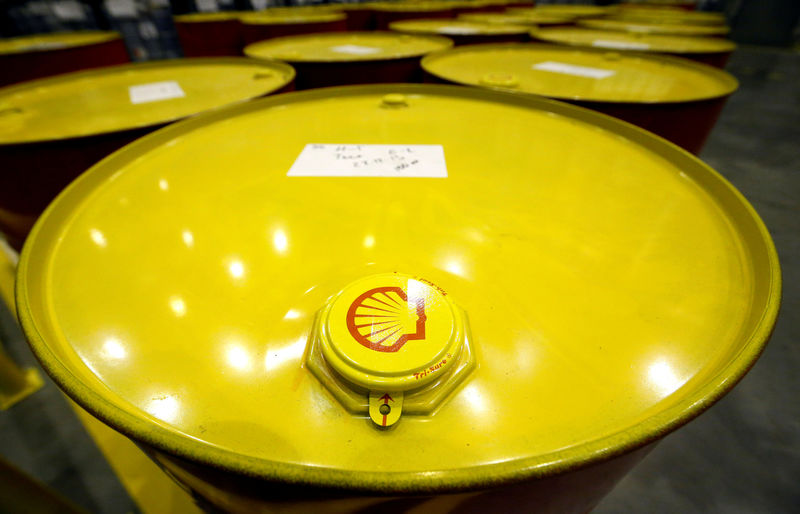 © Reuters. FILE PHOTO:Filled oil drums are seen at Royal Dutch Shell Plc’s lubricants blending plant in the town of Torzhok
© Reuters. FILE PHOTO:Filled oil drums are seen at Royal Dutch Shell Plc’s lubricants blending plant in the town of TorzhokBy Ron Bousso
LONDON (Reuters) – Penguins, Royal Dutch Shell’s (L:) latest oil and gas development in a remote corner of the British North Sea, epitomizes the new doctrine for deepwater projects — keep it cheap and simple.
Shunned during the oil price crash of 2014-2016, deepwater projects are being embraced again, a challenge to the surge in onshore U.S. shale output.
Penguins, the first new major deepwater project this year, will rejuvenate the 44-year-old field by drilling 8 new wells 165 meters (541 feet) underwater and connecting them to a new production vessel.
Due for completion in 2021 at a cost of around $1 billion, Penguins will cost a fraction of the average of giant developments earlier this decade, producing a modest 45,000 barrels of oil equivalent a day.
“It is another example of how we are unlocking development opportunities, with lower costs,” Andy Brown, head of Shell’s oil and gas production division, said.
GRAPHIC: http://reut.rs/2BpKCYe
Like Shell, companies such as Exxon Mobil (N:), Total (PA:) and BP (L:) have in recent years radically changed the way they design offshore fields – deploying steel platforms out at sea – to make them simpler and faster to build, and able to challenge the economics of shale fields such as the Permian basin in Texas.
As executives gain confidence that their companies can make a profit with oil at around $50 a barrel – less than half the level of the early 2010s – boards are set to approve more projects. Oil currently trades at around $60 a barrel.
Analysts at Bernstein expect around 40 new offshore projects to be approved in 2018, compared with 29 last year and 14 in 2016, when project numbers fell to the lowest since at least 1990.
Companies including Exxon, Shell and BP have set a rigid cost ceiling for new projects, requiring them to be profitable with oil at $40 a barrel in order to withstand an uncertain outlook clouded by the rise of electric vehicles.
As a result, most new projects are set to be significantly smaller than the traditional field size, averaging 42,000 barrels of oil equivalent per day, compared with 69,000 last year, according to Bernstein.
“You will see more deepwater over time, for sure,” Bernard Looney, head of BP’s oil and gas production division, told Reuters in January. BP is expected to approve a number of projects this year, he added, including in Senegal, Mauritania, Oman and Azerbaijan.
Leaner projects can be achieved by drilling simpler wells and connecting them to existing platforms and pipelines, in what is known as infill drilling, or by swapping bespoke gear for off-the-shelf equipment and by processing vast amounts of data to streamline oil field construction.
A sharp drop in rig and services costs, by as much as 80 percent in some cases over the past three years, has further helped reduce the cost of projects.
“Much is made of the Permian, its flexibility and the returns there. But actually infill drilling for a decade creates enormous sources of money,” Looney said.
DEEPWATER PROJECTS
There are exceptions to the rule. Some fields are so vast that they require massive investment, while remaining profitable at low oil prices.
Among the largest projects expected to be approved this year are Petrobras’s (SA:) Libra II in Brazil, at an expected cost of $10 billion, Shell’s Bonga Southwest in Nigeria at $12.2 billion and Exxon’s Mamba liquefied (LNG) project in Mozambique at $30 billion, according to analysts at Jefferies.
For all the buzz around shale production, it accounts for around 7 percent of the world’s crude supply of around 98 million barrels per day while offshore production accounts for over one quarter.
The scale of the highly complex projects – one platform can produce 150,000 bpd in some cases – helped tap new resources in recent decades to meet surging global demand for energy.
But some deepwater projects were plagued by huge cost over-runs and delays – one of the most famous examples being the giant Kazakh field Kashagan, later dubbed “cash-all-gone” as costs ballooned from $10 billion to $60 billion.
But after years of spending cuts, companies urgently need to develop new resources to offset the natural decline of fields, which can reach 10 percent per year.
“When you look at the mix you need offshore, you need deepwater. The onshore by itself won’t be enough to make up for the decline rates that you are seeing globally,” Lorenzo Simonelli, Chief Executive Officer of energy services company Baker Hughes (N:), told Reuters.
Exxon, the world’s top publicly traded oil company, last year gave the go-ahead for the development of the Liza field in Guyana. The project is expected to generate double-digit returns with oil at $40, the company said.
Oil majors have made a number of major discoveries in recent months – Exxon in Guyana, BP in the North Sea, Shell in the Gulf of Mexico, Eni and Total offshore Cyprus – and their development will hinge on keeping costs low.
“Discipline has to stay, we’re very determined in this space. We’re not going to say that now that the oil prices are back up, let’s do more, let’s spend more,” BP’s Looney said.
Source: Investing.com



























